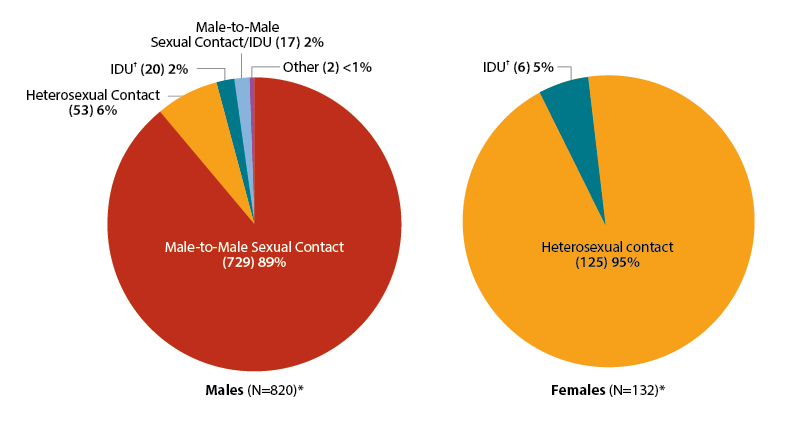HIV Among Asians in the United States
Fast Facts
- The number of HIV diagnoses among Asians in the United States increased in recent years.
- Among Asians, gay and bisexual men are most affected by HIV.
- Around 1 in 5 Asians living with HIV in the United States do not know they have it.

Between 2010 and 2014, the Asian populationa in the United States grew around 11%, more than three times as fast as the total U.S. population. During the same period, the number of Asians receiving an HIV diagnosis increased by 36%, driven primarily by an increase in HIV diagnoses among Asian gay and bisexual men.b Asians, who make up 6% of the population, continue to account for only a small percentage of new HIV diagnoses in the United States and 6 dependent areas.
The Numbers
HIV and AIDS Diagnosisc
- Asians accounted for 2% (959) of the 40,040 new HIV diagnoses in the United States and 6 dependent areas in 2015.d
- Of Asians diagnosed with HIV infection in 2015, 86% (820) were men and 14% (132) were women.
- Gay and bisexual men accounted for 89% (729) of all HIV diagnoses among Asian men in 2015. Among Asian women, 95% (125) of HIV diagnoses were attributed to heterosexual contact.e
- From 2010 to 2014, HIV diagnoses increased by 47% among Asian gay and bisexual men in the United States.
- In 2015, 326 Asians were diagnosed with AIDS, representing 2% of the 18,538 AIDS diagnoses in the United States and 6 dependent areas.
Living With HIV
- Of the 16,200 Asians estimated to be living with HIV in the United States in 2013, 22% (3,500) were undiagnosed, the highest rate of undiagnosed HIV among any race/ethnicity. By comparison, 13% of all persons living with HIV in the United States were undiagnosed.
- Of Asians diagnosed with HIV in 2014, 80% were linked to HIV medical care within 1 month of diagnosis, compared to 75% of all persons diagnosed with HIV that year.f
- Of Asians who had been living with diagnosed HIV for at least a year at the end of 2013, 56% were retained in care (receiving continuous HIV medical care), and 60% had achieved viral suppression,g slightly higher than the overall rate (55%) of viral suppression among all races/ethnicities.
HIV Diagnoses Among Adult and Adolescent Asians in the
United States and 6 Dependent Areas by Transmission Category and Sex, 2015

*Due to rounding, percentages might not total 100%.
†Injection drug use.
Source: CDC. Diagnoses of HIV infection in the United States and dependent areas, 2015. HIV Surveillance Report 2016;27.
Prevention Challenges
There are some behaviors that put everyone at risk for HIV. These include having vaginal or anal sex without a condom or without being on medicines that prevent HIV, or sharing injection drug equipment with someone who has HIV. Other factors that affect Asians particularly include:
- Undiagnosed HIV. People living with undiagnosed HIV cannot obtain the care they need to stay healthy and may unknowingly transmit HIV to others.
- Cultural factors. Some Asians may avoid seeking testing, counseling, or treatment because of language barriers or fear of discrimination, the stigma of homosexuality, immigration issues, or fear of bringing shame to their families.
- Limited research. Limited research about Asian health and HIV infection has resulted in few targeted prevention programs and behavioral interventions in this population.
- Data limitations. The reported number of HIV cases among Asians may not reflect the true HIV diagnoses in this population because of race/ethnicity misidentification. This could lead to the underestimation of HIV infection in this population.
What CDC Is Doing
CDC and its partners are pursuing a high-impact prevention approach to maximize the effectiveness of current HIV prevention methods, and improve surveillance among Asians. Funding state, territorial, and local health departments is CDC’s largest investment in HIV prevention.
- CDC provides support and technical assistance to health departments and community-based organizations to deliver prevention programs for Asians, such as The Banyan Tree Project.
- Capacity Building Assistance for High-Impact HIV Prevention provides technical assistance in capacity building to the Asian and Pacific Islander American Health Forum and the Asian and Pacific Islander Wellness Center.
- The CDC publication Effective HIV Surveillance Among Asian Americans and Native Hawaiians and Other Pacific Islanders outlines successful HIV surveillance activities for health departments in states with high concentrations of Asians.
- CDC is raising awareness through the Act Against AIDS campaigns, including
- Doing It, a new national HIV testing and prevention campaign that encourages all adults to know their HIV status and protect themselves and their community by making HIV testing a part of their regular health routine;
- Let’s Stop HIV Together, which raises HIV awareness and fights stigma among all Americans and provides many stories about people living with HIV; and
- HIV Treatment Works, which highlights how men and women who are living with HIV have overcome barriers.
a A person having origins in any of the original peoples of the Far East, Southeast Asia, or the Indian subcontinent including, for example, Cambodia, China, India, Japan, Korea, Malaysia, Pakistan, the Philippine Islands, Thailand, and Vietnam.
b The term male-to-male sexual contact is used in CDC surveillance systems. It indicates a behavior that transmits HIV infection, not how individuals self-identify in terms of their sexuality. This fact sheet uses the term gay and bisexual men.
c Dependent areas include American Samoa, Guam, the Northern Mariana Islands, Puerto Rico, the Republic of Palau, and the US Virgin Islands.
d HIV and AIDS diagnoses indicate when a person was diagnosed with HIV infection or AIDS, not when the person was infected.
e Heterosexual contact with a person known to have, or to be at high risk for, HIV infection.
f Data for medical care and viral suppression are from 32 states and the District of Columbia (the areas with complete lab reporting by December 2015).
g A person who has a suppressed viral load has a very low level of the virus. That person can stay healthy and has a dramatically reduced risk of transmitting the virus to others.
Bibliography
- CDC. Diagnoses of HIV infection in the United States and dependent areas, 2015. HIV Surveillance Report 2016;27. Accessed February 16, 2017.
- CDC. Monitoring selected national HIV prevention and care objectives by using HIV surveillance data—United States and 6 dependent areas—2014. HIV Surveillance Supplemental Report 2015;21(4). Accessed February 16, 2017.
- CDC. High-Impact HIV Prevention: CDC’s approach to reducing HIV infections in the United States. Accessed February 16, 2017.
- CDC. NCHHSTP Atlas Plus. Accessed February 16, 2017.
- CDC. Effective HIV surveillance among Asian Americans and Other Pacific Islanders. Accessed February 16, 2017.
- Hahm HC, Lee J, Rough K, Strathdee SA. Gender power control, sexual experiences, safer sex practices, and potential HIV risk behaviors among Asian-American women. AIDS Behav 2012;16(1):179-88.
- Russ LW, Meyer AC, Takahashi LM, et al. Examining barriers to care: provider and client perspectives on the stigmatization of HIV-positive Asian-Americans with or without viral hepatitis co-infection. AIDS Care 2012;24(10):1302-7.
- US Census Bureau. QuickFacts: United States. Accessed August 4, 2017.
Additional Resources
- CDC-INFO 1-800-CDC-INFO (232-4636)
- CDC HIV Website
- CDC Act Against AIDS Campaign
- CDC HIV Risk Reduction Tool (BETA)
- Page last reviewed: August 7, 2017
- Page last updated: September 21, 2017
- Content source: Division of HIV/AIDS Prevention, National Center for HIV/AIDS, Viral Hepatitis, STD, and TB Prevention, Centers for Disease Control and Prevention


 ShareCompartir
ShareCompartir